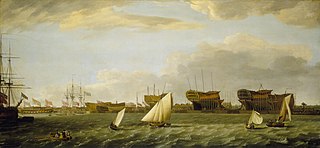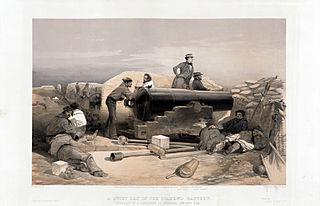
HMS Black Prince was the third ship of that name to serve with the Royal Navy. She was the world's second ocean-going, iron-hulled, armoured warship, following her sister ship, HMS Warrior. For a brief period the two Warrior-class ironclads were the most powerful warships in the world, being virtually impregnable to the naval guns of the time. Rapid advances in naval technology left Black Prince and her sister obsolete within a short time, however, and she spent more time in reserve and training roles than in first-line service.

HMS Defence was the lead ship of the Defence-class armoured frigates ordered by the Royal Navy in 1859. Upon completion in 1862 she was assigned to the Channel Fleet. The ship was paid off in 1866 to refit and be re-armed and was briefly reassigned to the Channel Fleet when she recommissioned in 1868. Defence had brief tours on the North Atlantic and Mediterranean Stations, relieving other ironclads, from 1869 to 1872 before she was refitted again from 1872 to 1874. She became guard ship on the Shannon when she recommissioned. The ship was transferred to the Channel Fleet again in 1876 and then became guard ship on the Mersey until 1885. Defence was placed in reserve until 1890 when she was assigned to the mechanical training school in Devonport in 1890. She was renamed Indus when the school adopted that name and served there until sold in 1935.

HMS Beagle was a wooden-hulled Arrow-class gunvessel second-class screw gunvessel launched in 1854 and sold in 1863. She was the third vessel of the Royal Navy to use the name.

The Algerine class gunboats were a class of six 3-gun wooden gunboats built for the Royal Navy in 1857. A further pair were built in India for the Bombay Marine in 1859.

The Arrow class comprised six second-class screw-driven vessels built as despatch vessels for the Royal Navy in 1854, mounting 6 guns. In 1856 they were redesignated as second-class gunvessels.

The Vigilant-class gunvessel of the Royal Navy was an enlarged version of the Arrow-class gunvessel of 1854. Both classes were designed for shallow-water operations in the Baltic and Black Seas during the Crimean War. Fourteen of the class were completed, but were ready too late to take part in that conflict. Cormorant was sunk in action at the Taku Forts, Osprey was wrecked on the coast of Africa in 1867 and the rest were all sold during the 1860s, with Sparrowhawk lasting until 1872.

The Rosario class was a class of seven screw-sloops of wooden construction built for the Royal Navy between 1860 and 1862. A further six vessels were ordered and laid down, but were cancelled in 1863 before launch. This was the last class of purely wooden sloops built for the Royal Navy.

HMS Mullett was a Royal Navy 5-gun Philomel-class wooden screw gunvessel launched in 1860. She served on the coast of West Africa and on the North America and West Indies Station before being sold in 1872 at Hong Kong for mercantile use. As the sailing ship Formosa she sailed in the Far East before being converted to a magazine in Melbourne.

The Condor-class gunvessel was a class of four Royal Navy composite gunvessels of 3 guns, built between 1876 and 1877. They were all hulked or sold before 1893, giving them an active life of less than 15 years.

HMS Sparrowhawk was a Vigilant-class second-class despatch/gunvessel launched on 9 February 1856 at Limehouse, England and served at various stations in the Far East. By the spring of 1865, her rig was a converted to that of a three-masted barque. She was sold in 1872 and was eventually lost in a typhoon.

HMS Eclipse was a 4-gun Cormorant-class first class gunvessel launched in 1860 from the shipyard of J. Scott Russell & Co., Millwall. She served on the Australia Station, took part in the Second Taranaki War, including contributing men to a naval brigade which attacked the Maori stronghold at Gate Pā. The entire class were never satisfactory as gunvessels, partly due to their excessive draught, and Eclipse was broken up at Sheerness in 1867, only 7 years after her launch.
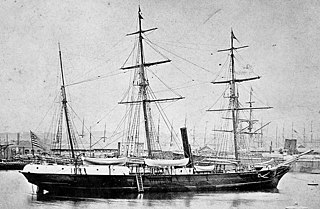
The Philomel-class gunvessel was a class of wooden-hulled screw-driven second-class gunvessels built for the Royal Navy between 1859 and 1867, of which 26 were ordered but only 20 completed. They had a mixed history, with some serving for as little as 5 years, and others surviving into the 1880s. Two of the class were sold and used as Arctic exploration vessels, both eventually being lost in the ice.

HMS Myrmidon was a Cormorant-class gunvessel of the Royal Navy, built at Chatham Dockyard and launched in 1867. She served on the North America and West Indies Station and surveyed parts of the Australian coast before being sold at Hong Kong in 1889.
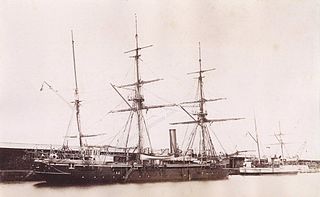
HMS Rambler was an Algerine-class gunvessel of the Royal Navy, built by John Elder & Co., Glasgow and launched on 26 January 1880. She was commissioned as a survey vessel in 1884 and served in Chinese waters during the 1880s and 1890s. She provided men to a naval brigade during the Boer War and was sold on 23 January 1907.

The Algerine-class gunvessel was a class of three Royal Navy composite gunvessels built in 1880. Two of them were sold after only ten years of service, but the other was converted to a survey ship before commissioning and survived in this role until 1907.
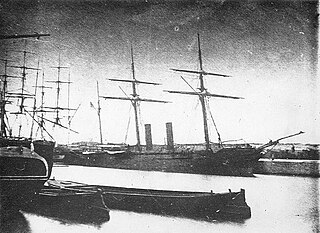
Intrepid-class gunvessels were a class of six Royal Navy first-class wooden gunvessels built in 1855-56. They were rated as sloops from 1859 to 1862, and were scrapped by 1865. Victor was sold to the Confederate States of America as the raider CSS Rappahannock, but she was interned by the French at Calais and never fulfilled her intended function.
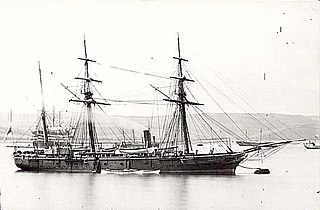
HMS Arab was an Arab-class composite gunvessel built for the Royal Navy in 1874. She served in the East Indies and was sold in 1889.

The Forester-class gunboat was a class of 4-gun composite gunboats built for the Royal Navy between 1874 and 1877. Although half had been sold by 1890, the rest survived into the 20th century as coal hulks, base vessels and other secondary uses. Foxhound survived as a hulk on the Blackwall Reach of the Thames until 1975, when she was broken up. They were built of composite construction, that is, with iron keel, stem and stern posts, and iron framing, but planked with wood.

The Cormorant-class gunvessels were a class of 4-gun first-class gunvessels built for the Royal Navy in the 1860s. They were somewhat unsuccessful; intended for shore bombardment in shallow water, they exceeded their design draft by 50%. Seven of the 13 ships ordered were suspended, with 3 finished or converted as survey ships and the other 4 cancelled. Racehorse was wrecked after only 4 years, and those ships that were completed as planned had short operational lives, in some cases less than 10 years. The survey vessels lasted longest, with the last ship of the class, Sylvia, being broken up in 1890.

The Conflict-class sloop was a class of two first-class wooden screw sloops built for the Royal Navy in the mid 1840s. Two other ships were ordered but cancelled shortly afterwards. Both completed ships served in the Baltic during the Crimean war, and Desperate briefly served as a store ship to Edward Augustus Inglefield's Arctic expedition. They had both been broken up by 1865.


